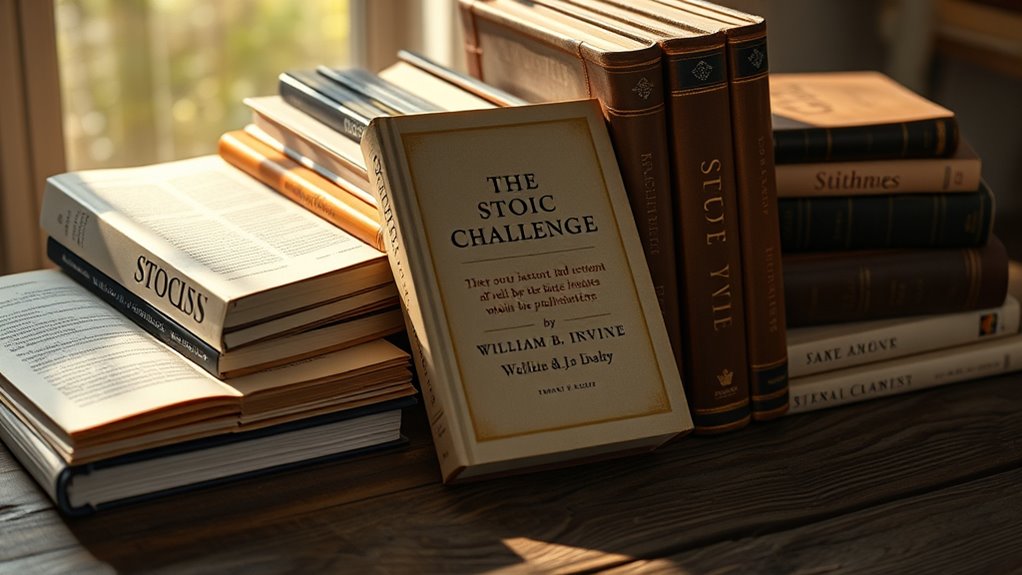To learn Stoicism effectively, start with classics like *Meditations* by Marcus Aurelius and *Letters From a Stoic* by Seneca, which give timeless insights into virtue and resilience. Supplement with *Discourses* by Epictetus for practical wisdom, and modern guides like *The Daily Stoic* by Ryan Holiday or *A Guide to the Good Life* by William B. Irvine for daily application. Exploring these works will deepen your understanding and help you incorporate Stoic principles into life—more awaits as you continue.
Key Takeaways
- *Meditations* by Marcus Aurelius offers timeless personal reflections on virtue, discipline, and inner strength foundational to Stoic practice.
- *Letters from a Stoic* by Seneca provides practical advice on resilience, adversity, and ethical living through real-life correspondence.
- *Discourses and Selected Writings* by Epictetus emphasizes control, mindfulness, and daily application of Stoic principles.
- *The Daily Stoic* by Ryan Holiday and Stephen Hanselman promotes daily routines, reflections, and habits to integrate Stoicism into modern life.
- Modern guides like *A Guide to the Good Life* and *How to Be a Stoic* offer accessible summaries, techniques, and practical exercises for applying Stoic philosophy today.
Meditations* by Marcus Aurelius

“Meditations” by Marcus Aurelius is a timeless classic that offers profound insight into Stoic philosophy. As you read, you’ll discover how the Roman emperor reflects on inner strength, discipline, and virtue. This journal-style collection reveals his personal struggles and methods for maintaining calm amid chaos. You’ll learn to focus on what you can control and accept what you cannot, fostering resilience and clarity. The book encourages you to examine your thoughts daily, promoting a mindset rooted in reason and humility. The practical wisdom helps you develop emotional resilience, deal with adversity, and live ethically. Additionally, understanding the concept of self-awareness can deepen your practice of Stoicism, helping you recognize and manage your emotions more effectively. Exploring emotional resilience within the text can provide valuable tools for handling life’s challenges with equanimity. Cultivating a mindful attitude as emphasized in the writings can further enhance your ability to stay centered during difficult times. Developing a growth mindset through these teachings can also inspire continuous personal improvement and adaptability.
Letters From a Stoic* by Seneca

“Letters From a Stoic” by Seneca offers a collection of practical advice and philosophical reflections that you can apply directly to everyday life. This book provides insights into how to handle adversity, manage desires, and cultivate resilience.
Seneca’s letters address real-life issues, making Stoicism accessible and relevant. To deepen your understanding, focus on these key themes:
- Self-control – Learn how to master emotions and avoid impulsive reactions.
- Acceptance – Embrace life’s hardships as opportunities for growth.
- Virtue – Prioritize moral integrity over material wealth.
- Mindfulness – Practice constant reflection to stay aligned with your values.
Discourses and Selected Writings* by Epictetus

In “Discourses and Selected Writings” by Epictetus, you’ll find essential philosophical ideas that challenge how you view control, virtue, and happiness. These texts also offer practical tips to help you apply Stoic principles in everyday life. Exploring these writings will deepen your understanding of Stoicism’s core teachings and how to live them out. Incorporating well-structured content based on these teachings can enhance your ability to communicate Stoic concepts effectively and foster a more reflective mindset. Additionally, understanding philosophical quotes can inspire and motivate you to embody Stoic virtues in various aspects of life. Recognizing the importance of ethical practices in Stoicism can further strengthen your personal development and resilience. Furthermore, the integration of AI-powered virtual reality in e-learning can provide immersive environments to practice Stoic reflections and scenarios. Being aware of projector bulb maintenance techniques can also serve as a metaphor for maintaining clarity and focus in philosophical practice, ensuring your mental and emotional ‘devices’ stay well-functioning.
Key Philosophical Ideas
Have you ever wondered how to distinguish what’s within your control from what isn’t? Epictetus’s key ideas focus on this distinction, urging you to focus on your own responses and attitudes. His teachings emphasize that happiness depends on your internal judgments rather than external events.
To grasp this, consider these core concepts:
- Control and Acceptance: Only your thoughts, choices, and reactions are truly yours—everything else is indifferent.
- Virtue as the Highest Good: Living morally and wisely is the ultimate aim, regardless of external circumstances.
- Dichotomy of Nature: Understanding what’s natural and inevitable helps you accept hardships.
- Mindfulness and Self-Discipline: Constant awareness of your thoughts fosters resilience and clarity.
These ideas guide you toward inner tranquility amidst external chaos.
Practical Application Tips
Applying Epictetus’s teachings from his Discourses and Selected Writings involves translating philosophical principles into everyday actions. Start by recognizing what’s within your control and what’s not. When faced with challenges, pause and ask yourself if you can change the situation or your response.
Focus on your reactions, not external events. Practice daily reflection by reviewing your actions and thoughts, identifying areas for improvement. Use mindfulness to remain present and avoid reacting impulsively. Cultivating your creative practice can also help develop resilience and adaptability in facing life’s challenges. Emphasizing the importance of mental and emotional well-being can further support your personal growth. Incorporating spiritual energy awareness into your routine can enhance your capacity for inner peace and resilience. Additionally, understanding the cybersecurity vulnerabilities that affect our digital lives can help you better manage your online responses and protect your personal information. Recognizing the influence of relationships on your emotional state can aid in maintaining a balanced perspective and fostering healthy interactions.
The Daily Stoic* by Ryan Holiday and Stephen Hanselman

“The Daily Stoic” by Ryan Holiday and Stephen Hanselman offers a practical approach to incorporating Stoic philosophy into your everyday life. It delivers daily reflections that prompt you to think deeply about resilience, virtue, and self-control. Using consistent habits like daily reading and reflection can help reinforce Stoic principles and make them a natural part of your routine. To maximize its benefits, consider:
- Setting aside a specific time each morning for reading and reflection
- Journaling your thoughts and responses to daily lessons
- Applying insights immediately to real-life situations throughout the day
- Reviewing past entries regularly to track your progress in practicing Stoicism
- Recognizing the importance of mental discipline in maintaining a Stoic mindset and resisting impulsive reactions.
- Remember that understanding Stoic philosophy can deepen your practice and help you navigate life’s challenges more effectively.
- Emphasizing emotional resilience as a core aspect of Stoic practice can further strengthen your daily application and understanding.
- Developing habit formation around key principles can solidify your commitment to Stoic virtues over time.
A Guide to the Good Life: The Ancient Art of Stoic Joy* by William B. Irvine

Building on the daily reflections of Stoicism, William B. Irvine offers practical guidance in *A Guide to the Good Life*. You’ll learn how to cultivate joy by focusing on what truly matters and practicing techniques like negative visualization—imagining loss to appreciate what you have.
Irvine emphasizes managing desires, so you’re less driven by external goods and more grounded in inner contentment. He presents Stoic philosophy as a way to achieve tranquility amid life’s inevitable challenges.
Instead of abstract theory, his book provides actionable steps to integrate Stoicism into everyday life. As you explore these methods, you’ll discover how to reduce anxiety, increase resilience, and find a sense of joy rooted in virtue and perspective.
This approach makes Stoicism accessible and relevant for modern living.
Stoicism and the Art of Happiness* by Donald Robertson

- Understanding the nature of happiness and how it’s rooted in virtue.
- Recognizing the role of emotions and how to manage them effectively.
- Developing self-discipline through practical exercises.
- Using Stoic techniques like negative visualization to prepare for setbacks.
- Incorporating sound recording techniques to enhance the clarity and impact of your reflections.
- Exploring mental clarity methods can further improve your ability to reflect and internalize Stoic teachings.
- Studying unique and wicked planters can offer insights into cultivating resilience and adaptability in your personal growth. Additionally, exploring dog breed characteristics can help deepen your understanding of specific traits and behaviors, which can be useful when applying Stoic principles to everyday challenges.
Furthermore, understanding the benefits of chia seeds for weight loss can serve as a metaphor for cultivating patience and consistency in your Stoic practice, emphasizing the importance of small, sustained efforts over time.
How to Be a Stoic* by Massimo Pigliucci

In “How to Be a Stoic,” you’ll find practical advice on applying Stoic principles to everyday life. Pigliucci combines modern philosophy with personal growth strategies, making the ideas accessible and relevant today.
This book shows you how to develop resilience and clarity through a contemporary, actionable approach.
Practical Stoic Applications
- Reflect daily on your reactions and emotions to identify areas for growth.
- Practice negative visualization to prepare for setbacks and appreciate what you have.
- Distinguish between controllables and uncontrollables, directing your energy only toward what you can influence.
- Develop resilience by viewing challenges as opportunities to strengthen your character.
Modern Philosophical Approach
Building on practical techniques, Massimo Pigliucci’s *How to Be a Stoic* offers a modern philosophical perspective that emphasizes integrating Stoic principles into everyday life. Instead of viewing Stoicism as mere ancient philosophy, Pigliucci presents it as a living, adaptable approach.
He combines classical ideas with contemporary philosophy, encouraging you to question assumptions and develop a reflective mindset. The book highlights that Stoicism isn’t just about discipline but also about understanding your values and aligning actions accordingly.
Pigliucci advocates for reasoned self-examination and critical thinking, making Stoicism relevant in today’s complex world. His approach helps you see Stoic virtues as practical tools for *steering* challenges, fostering resilience, and cultivating a meaningful, balanced life amid modern uncertainties.
Personal Growth Strategies
Have you ever wondered how to turn Stoic principles into everyday habits that foster personal growth? To do this, focus on practical strategies.
First, practice daily reflection to assess your reactions and improve self-awareness.
Second, set intentional goals aligned with virtue, such as patience or resilience.
Third, embrace discomfort intentionally, like cold showers or difficult conversations, to build endurance.
Fourth, cultivate gratitude by regularly acknowledging what you have and letting go of what you can’t control.
These steps help embed Stoic teachings into your routine, turning abstract ideas into tangible actions.
Consistency is key—over time, these habits will transform your mindset, making Stoicism a natural part of your personal development journey.
The Stoic Challenge* by William B. Irvine

The Stoic Challenge by William B. Irvine offers practical advice for transforming setbacks into opportunities for growth. You learn to view obstacles not as threats but as chances to practice resilience and virtue.
Irvine introduces techniques rooted in Stoic philosophy, such as premeditatio malorum—anticipating challenges to reduce their impact—and turning adversity into a skill-building exercise.
The book emphasizes that your reactions, not external events, determine your well-being. It’s a straightforward guide that helps you reframe difficulties, making them less formidable.
Frequently Asked Questions
Which Book Offers the Most Practical Daily Exercises for Beginners?
When you’re looking for a book that provides practical daily exercises, “The Daily Stoic” by Ryan Holiday is a great choice.
It offers bite-sized lessons and actionable steps you can incorporate into your routine. You’ll find reflections, prompts, and exercises designed specifically for beginners, making it easier to practice Stoicism daily.
This book helps you build habits gradually, so you can develop resilience and peace over time.
How Do These Books Address Modern Challenges Using Stoic Principles?
You find that these books tackle modern challenges by applying timeless Stoic principles like resilience, self-control, and acceptance. They show you how to stay calm amid chaos, manage stress, and focus on what you can control.
Through practical examples and relatable advice, you learn to navigate social media pressures, workplace stress, and personal setbacks, empowering you to maintain inner peace and clarity in today’s fast-paced world.
Are There Any Audiobooks or Podcasts Related to These Texts?
They say, “Listening is an art,” and you can master it with audiobooks or podcasts. Luckily, many of these texts offer audio versions on platforms like Audible or Spotify, making it easy for you to learn on the go.
Podcasts such as The Daily Stoic or The Practical Stoic discuss these ideas in a conversational style, helping you apply stoic principles to modern challenges while fitting into your busy schedule.
How Do Cultural Differences Influence the Interpretation of Stoic Teachings?
Cultural differences shape how you interpret stoic teachings by influencing your values, beliefs, and social norms. You might find that certain principles resonate more deeply or seem challenging depending on your cultural background.
You adapt the philosophy to fit your context, emphasizing aspects that align with your worldview. This diversity enriches your understanding and helps you apply stoicism in a way that feels authentic and meaningful within your cultural framework.
Can These Books Be Effectively Combined for a Comprehensive Understanding?
This question cuts through complexities like a sword through steel. You can definitely combine these books for a richer understanding. Each offers unique perspectives that, when merged, create an all-encompassing view of Stoicism.
Approach them as pieces of a grand puzzle, and you’ll find that your grasp of Stoic principles deepens exponentially. It’s like building a sturdy fortress of wisdom, brick by brick, for a resilient, well-rounded mindset.
Conclusion
By exploring these books, you’ll gain timeless wisdom and practical strategies to navigate life’s uncertainties. Unlike fleeting trends or fleeting emotions, stoicism offers steady resilience and inner peace. It’s a journey from chaos to clarity, from reactive to deliberate. Embrace this path, and you’ll find strength not just in moments of calm, but also amidst chaos—transforming challenges into opportunities for growth and serenity.









